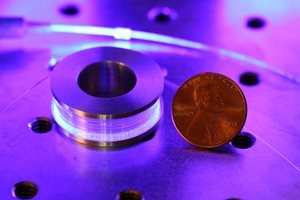Feb 1 2019
A compact laser recently developed by scientists exhibits the ability to emit light with exceptional spectral purity that does not vary based on environmental conditions.
 A newly developed fiber laser emits extremely pure light that isn’t sensitive to environmental conditions. Because the fiber used to make the laser takes up little space, the new technology could enable a stable, narrow linewidth laser that is portable. (Image credit: William Loh, Massachusetts Institute of Technology Lincoln Laboratory)
A newly developed fiber laser emits extremely pure light that isn’t sensitive to environmental conditions. Because the fiber used to make the laser takes up little space, the new technology could enable a stable, narrow linewidth laser that is portable. (Image credit: William Loh, Massachusetts Institute of Technology Lincoln Laboratory)
The newly developed potentially portable laser could be advantageous to a plethora of scientific applications, optimize the detection of gravitational waves in space, enhance clocks for global positioning (GPS) systems, and be useful for quantum computing.
Scientists from the Massachusetts Institute of Technology’s Lincoln Laboratory, USA, have reported their new laser in Optica, The Optical Society’s journal for high-impact research.
Even if a laser is developed to emit absolutely in a single wavelength, variations in temperature and other environmental factors usually introduce noise, resulting in shifting of the light emission or widening of its frequency. The widened spectral extent of this emission is called the laser linewidth. The scientists employed a new strategy to develop an optical fiber laser that has a spectral linewidth narrower compared to that achieved ever before by a semiconductor or fiber laser. The same laser also offers a technique for sensing and making corrections for temperature variations as low as 85 nK, or 85 billionths of a degree.
Today, ultra-low expansion (ULE) cavity lasers exhibit the narrowest linewidth and highest performance, but they are bulky and very sensitive to environmental noise. Our goal is to replace ULE lasers with one that could be portable and isn’t sensitive to environmental noise.
William Loh, Study First Author, Massachusetts Institute of Technology Lincoln Laboratory.
Achieving Narrow Linewidth
The scientists designed a laser based on a short loop (~2 m) of optical fiber structured as a ring resonator. Fiber lasers are robust and compact and tend to react to environmental changes comparatively slowly. The scientists integrated the benefits of fiber with a nonlinear optical effect called Brillouin scattering to realize a laser with a linewidth of merely 20 Hz. By contrast, other fiber lasers can realize linewidths from 1000 to 10,000 Hz, and the linewidth typically achieved by off-the-shelf semiconductor lasers is around 1 million Hertz.
In view of long- and short-term environmental changes, to render the laser highly stable, the scientists devised a method for referencing the laser signal against itself to sense changes in temperature. Their technique is extremely sensitive than other strategies for measuring temperature and enables calculating an accurate correction signal that can be employed to bring the laser back to the emission wavelength of the original temperature.
“Temperature is an important contributor to laser noise,” stated Loh. “A high-quality laser needs to not only have a narrow laser linewidth but also a way to keep that emission stable over the long term.”
Improving GPS
It would be possible to use this new light source to enhance a new generation of optical atomic clocks used for GPS-enabled devices. GPS allows users to point out their location on Earth by triangulating with the signals they receive from a network of satellites that are fitted with sophisticated atomic clocks. Each satellite offers a time stamp, and the system calculates a location using the relative differences among those times.
We think that atomic clocks based on our stable, narrow linewidth laser could be used to more precisely pinpoint the signal’s time of arrival, improving the location accuracy of today’s GPS systems. The fact that our laser is compact means it could be used aboard satellites.
William Loh, Study First Author, Massachusetts Institute of Technology Lincoln Laboratory.
The laser could also be advantageous for interferometers such as the ones used by the Laser Interferometer Gravitational-wave Observatory (LIGO) to detect gravitational waves that emerge out of collapsing stars or colliding black holes. Ultrastable lasers are essential for this application since laser noise hinders the ability of the interferometer to detect the very small perturbations of a gravitational wave.
“There are efforts underway to use lasers in space to create longer interferometer arms for gravitational wave observation,” stated Loh. “Due to its compact size and robustness, our laser might be a candidate for gravitational wave detection in space.”
According to the researchers, although their new laser is rugged, at present, it is a benchtop system appropriate for laboratory use. Currently, they are making efforts to create smaller packaging for the laser and will include smaller optical components to develop a portable version that might be as small as a smartphone.